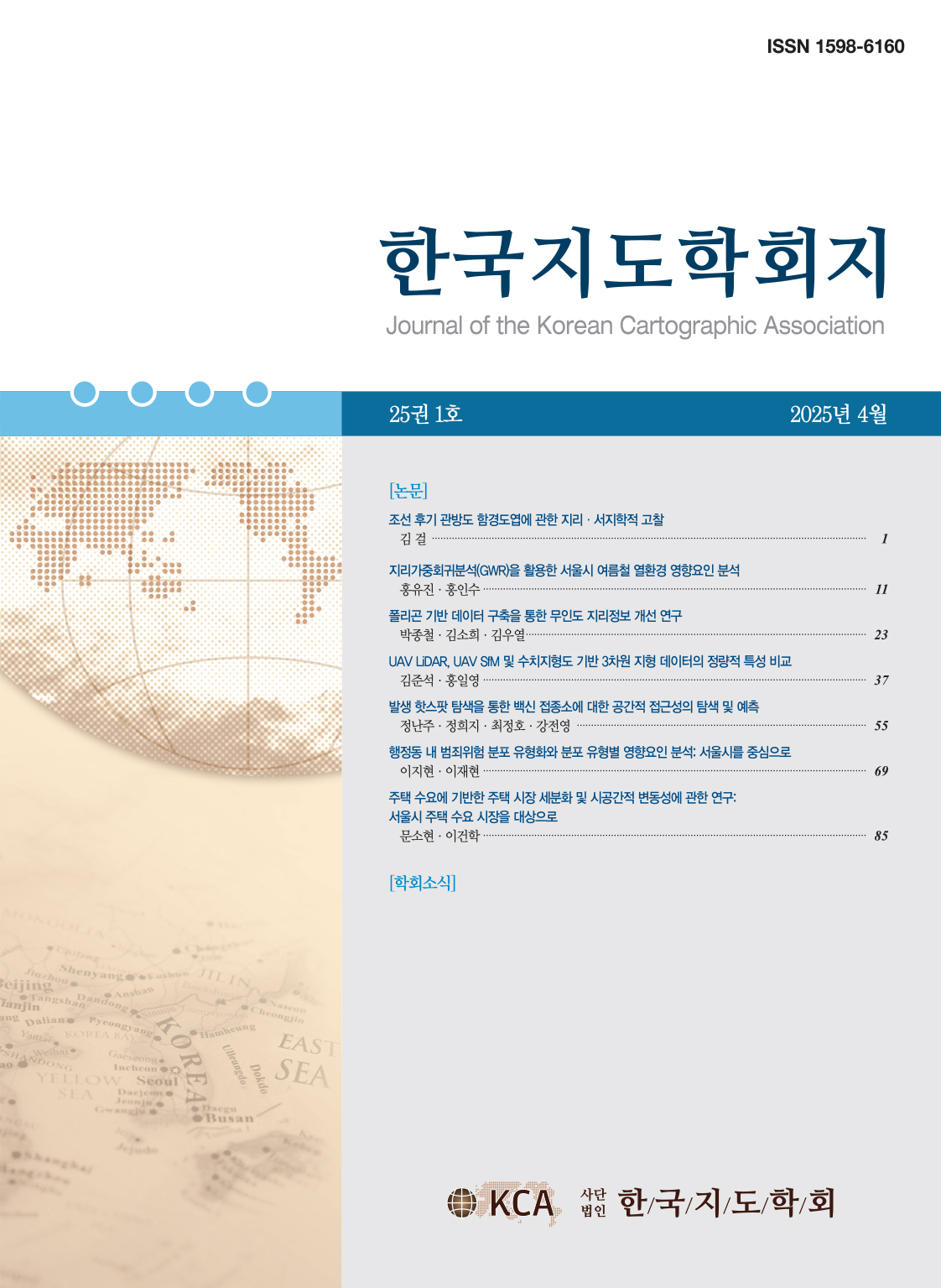Research Article
Abstract
References
Information
This study aims to successfully implement “Inquiry on Cities for the Future,” a new high school subject introduced in the 2022 revised curriculum, as a distinctive advanced and elective course in geography. To achieve this, a web-based GIS platform was developed to enhance digital literacy and simplify the use of geographic information through integrated tools for data preprocessing, visualization, and spatial analysis. Designed with HTML and JavaScript, the platform ensures accessibility across diverse educational environments, including low-end devices. This study also proposed a geographical inquiry-based teaching method, enabling students to explore urban dynamics and spatial inequalities through scientific analysis, personal reflection, and critical thinking. By integrating public data with geospatial technologies, this research contributes to advancing digital literacy and fostering critical inquiry skills in geography education.
본 연구의 목적은 2022 개정 교육과정 고등학교 신설 과목인 「도시의 미래 탐구」가 학교 현장에서 성공적으로 안착하고 지리교과의 심화과목이자 진로 선택 과목으로서의 정체성을 살리기 위한 방안으로 공공데이터를 활용한 웹 기반 GIS 플랫폼을 개발하고, 교수・학습 모듈을 디자인하는 것이다. 이 플랫폼은 데이터 전처리, 시각화, 공간 분석을 위한 통합 도구를 제공하며, HTML과 JavaScript로 설계되어 저사양 기기를 포함한 다양한 교육 환경에서도 활용 가능하다. 본 연구는 또한 「도시의 미래 탐구」교육과정에 부합하는 교수・학습 모듈을 개발하고, 지리탐구의 수업 실행 방식을 제안하였다. 학습자는 ‘도시’라고 하는 시민성의 공간을 과학적 인식, 개인적 반응, 비판적 사고를 통해 온전히 이해하게 되고, 도시의 역동성과 공간 불평등을 탐구할 수 있도록 설계되었다. 본 연구는 공공데이터와 지리정보기술을 통합한 본 연구는 지리교육에서 디지털 리터러시를 증진하고 비판적 탐구 역량을 강화한다는 점에서 의의가 있다.
- 교육부, 2021, 더 나은 미래, 모두를 위한 교육 2022 개정 교육 과정 총론 주요사항 발표 자료집.
- 교육부, 2022a, 「초・중등학교 교육과정 총론」, 교육부 고시 제2022-33호 [별책 7].
- 교육부, 2022b, 「사회과 교육과정」. 교육부 고시 제2022-33호 [별책 7].
- 교육부, 2023, 보도자료: 디지털 기반 교육 혁신 방안 - 인공지능을 활용한 디지털 교육으로 ‘모두를 위한 맞춤 교육 시대’ 연다(2023.02.23.).
- 구자용・김대영・김민호・김화환・박선엽・박수홍・안재성・오충원・정재준・최진무・황철수, 2014 역, 「지리정보시스템」, 서울: 시그마프레스(Jensen, J.R. and Jensen, R.R., 2013, Introductory Geographic Information Systems, NJ: Pearson Education).
- 김감영・이건학, 2002, “지리교육에서 Internet GIS 의 활용,” 대한지리학회 학술대회논문집, 133-140.
- 김민성, 2010, “교육 현장의 GIS 관련 상황과 교육적 사용을 위해 고려해야 할 요소,” 한국지리환경교육학회지, 18(2), 173-184. https://doi.org/10.17279/jkagee.2010.18.2.17310.17279/jkagee.2010.18.2.173
- 김민성, 2023, “감정지리학 기반 공간 이야기 만들기 프로젝트의 교육적 효과,” 한국지리학회지, 12(2), 281-295. https://doi.org/10.25202/JAKG.12.2.210.25202/JAKG.12.2.2
- 김남신, 2006, “WebGIS 을 이용한 고등학교 지리학습교재 개발,” 한국지역지리학회지, 12(2), 281-290.
- 김용완・다왕가・본보우・박기성・이영구, 2015, “통계지리 공공데이터를 이용한 표준지공시지가 예측,” 한국정보과학회 학술발표논문집.
- 양숙희・성효현, 2007, “GIS 현장 요구분석을 기반으로 한 전문계 고등학교에서의 GIS 교육내용 개발,” 한국지도학회지, 7(2), 33-51.
- 오정심, 2023, “빅데이터 의미망 분석을 활용한 ‘문화경관 형용사 목록’개발,” The Journal of Cultural Policy, 37(2), 131-160. https://doi.org/10.16937/jcp.2023.37.2.13110.16937/jcp.2023.37.2.131
- 윤옥경・한정혜, 2014, “초등 사회과 지리교육의 지도학습에서 교사의 웹지도 활용실태,” 한국지도학회지, 14(2), 39-52. https://doi.org/10.16879/jkca.2014.14.2.03910.16879/jkca.2014.14.2.039
- 이규영・김영훈, 2020, “오픈스트리트맵 활용 수업과 학생 활동 연구: 중학교 자유학기제를 사례로,” 한국지도학회지, 20(2), 87-98. https://doi.org/10.16879/jkca.2020.20.2.08710.16879/jkca.2020.20.2.087
- 이수경・엄석진, 2023, “공공데이터 활용 성과와 결정요인 분석: 공공데이터를 활용한 모바일 앱을 중심으로,” 행정논총, 61(1), 41-76. https://doi.org/10.24145/KJPA.61.1.210.24145/KJPA.61.1.2
- 이종원, 2011, “공간정보기술을 활용한 교수・학습모듈의 개발과 평가,” 한국지리환경교육학회지, 19(3), 381-397. https://doi.org/10.17279/jkagee.2011.19.3.38110.17279/jkagee.2011.19.3.381
- 이진희・임미영, 2022, “「도시의 미래 탐구」교육과정 기본방향,” 대한지리학회 학술대회논문집.
- 이진희・임미영, 2023, “2022 개정 고등학교 「도시의 미래 탐구」 교육과정의 개발 방향과 특징,” 한국지리환경교육학회지, 31(2), 27-38. https://doi.org/10.17279/jkagee.2023.31.2.2710.17279/jkagee.2023.31.2.27
- 윤철희・한기형, 2023, “공공데이터 분석을 통한 변동성 요인 분석과 예측 모델 생성에 대한 연구,” 한국산학기술학회 논문지, 24(12), 752-757. https://doi.org/10.17279/10.5762/KAIS.2023.24.12.75210.5762/KAIS.2023.24.12.752
- 조철기・권정화, 2005, “지리적 자아로서의 학습자와 지리탐구에 근거한 학습의 논리,” 한국지리환경교육학회지, 13(3), 333-347.
- 정인철・김지희, 2006, “고등학교 지리 수업에서의 GIS 활용 방안,” 한국지리환경교육학회지, 14(4), 251-262.
- 차조일・김혜숙・박주현・배화순・김상범・조철기・김병연・강선주・오정현・박형준・이영호・김민재・차승한, 2021, 「역량 함양 사회교과군 교육과정 재구조화 연구」, 한국교육과정평가원 연구보고서.
- 채민수, 2024, “지리교과의 에듀테크 활용실태 및 활성화 방안,” 한국지역지리학회지, 30(3), 408-427, https://doi.org/10.26863/JKARG.2024.8.30.3.40810.26863/JKARG.2024.8.30.3.408
- 함경림・김형숙・오선민・조성욱・이종원, 2024, “공간정보웹서비스, 공공 빅데이터, AI 를 활용한 지리교사 연수 설계 및 평가,” 한국지리환경교육학회지, 32(2), 1-19. https://doi.org/10.17279/jkagee.2024.32.2.110.17279/jkagee.2024.32.2.1
- 황상일・이금삼, 1996, “고등학교 지리학습에서 GIS 교육의 현황과 전망,” 한국지역지리학회지, 2(2), 219-231.
- Baker, T.R., Palmer, A.M., and Kerski, J.J., 2009, A national survey to examine teacher professional development and implementation of Desktop GIS, Journal of Geography, 108(4-5), 174-185. https://doi.org/10.1080/0022134090343593410.1080/00221340903435934
- Bednarz, S.W. and Bednarz, R.S., 2008, The key to success in using geospatial technologies in the social science classroom, in Milson, A.J. and Alibrandi, M.(eds.), Digital Geography, Charlotte, NC: Information Age Publishing..
- Bruner, J.S., 1961, The act of discovery, Harvard Educational Review, 31(1), 21-32.
- Chun, B.A., 2010, Effect of GIS-integrated Lessons on Spatial Thinking Abilities and Geographical Skills, Journal of Korean Geographical Society, 45(6), 820-844.
- Chun, B. and Hong, I.Y., 2007, Integrating GIS with geographic and environmental education into K-12: An interdisciplinary curriculum development entitled studying the environment of Eighteenmile Creek, Journal of the Korean Geographical Society, 42(2), 295-313.
- Dewey, J., 1938, Experience and Education, New York: Touchstone.
- Edelson, D.C., Smith, D.A., and Brown, M., 2008, Bring data analysis with GIS into the social studies classroom, in Milson, A.J. and Alibrandi, M. (eds.), Digital Geography: Geo- spatial Technologies in the Social Studies Classroom, Information Age, Charlotte, NC, 77-98.
- ESRI, 2011, ArcGIS DeskTop Help, Redlands: ESRI, Inc.
- Kerski, J.J., 2003, The implementation and effectiveness of geographic information systems technology and methods in secondary education. Journal of geography, 102(3), 128-137. https://doi.org/10.1080/0022134030897853410.1080/00221340308978534
- Lee, J., 2023, Beyond Geospatial Inquiry—How Can We Integrate the Latest Technological Advances into Geography Education?, Education Sciences, 13(11), 1128.10.3390/educsci13111128
- Liu, S. and Zhu, X., 2008, Designing a structured and interactive learning environment based on GIS for secondary geography education, Journal of Geography, 107(1), 12-19. https://doi.org/10.1080/0022134080194442510.1080/00221340801944425
- Marsh, M. Golledge, R.G., and Battersby, S.E., 2007, Geospatial concept understanding and recognition in G6-college students: A preliminary argument for Minimal GIS, Annals of the Association of American Geographers, 97(4), 696-712. https://doi.org/10.1111/j.1467-8306.2007.00578.x10.1111/j.1467-8306.2007.00578.x
- National Research Council, 2000, Inquiry and the National Science Education Standards: A guide for teaching and learning, Washington, DC: National Academy Press.
- Roberts, M., 2010, Geographical enquiry, Teaching geography, 35(1), 6.10.1111/j.1931-0846.2000.tb00321.x
- Stephens-Davidowitz, Seth, 2022, Don’t Trust Your Gut: Using Data to Get What You Really Want in Life, Dey Street Books.
- Slater, F., 1993, Learning through Geogrpahy, Indiana: National Council for Geographic Education.
- Slater, F., 1994, Education through geography: knowledge, understanding, values and culture. Geography, 147-163.10.1080/20436564.1994.12452438
- Slater, F., 1996, Values: towards mapping in their location in a geography education, in Kent, A., Naish, M., and Slater, F. (eds.), Geography in Education: Viewpoint on Teaching and Learning, Cambridge: Cambridge University Press, 200-230.
- Summerby-Murray, R., 2001, Analysing heritage landscapes with historical GIS: contributions from problem-based inquiry and constructivist pedagogy. Journal of Geography in Higher Education, 25(1), 37-52. https://doi.org/10.1080/0309826002002662410.1080/03098260020026624
- West, B.A., 2003, Student attitudes and the impact of GIS on thinking skills and motivation, Journal of geography, 102(6), 267-274. https://doi.org/10.1080/0022134030897855810.1080/00221340308978558
- Yuan, K., Cheng, X., Gui, Z., Li, F., and Wu, H., 2019, A quad-tree-based fast and adaptive Kernel Density Estimation algorithm for heat-map generation. International Journal of Geographical Information Science, 33(12), 2455–2476. https://doi.org/10.1080/13658816.2018.155583110.1080/13658816.2018.1555831
- 통계지리정보서비스, https://sgis.kostat.go.kr/view/index
- Publisher :The Korean Cartographic Association
- Publisher(Ko) :한국지도학회
- Journal Title :Journal of the Korean Cartographic Association
- Journal Title(Ko) :한국지도학회지
- Volume : 24
- No :3
- Pages :103~119
- DOI :https://doi.org/10.16879/jkca.2024.24.3.103



 Journal of the Korean Cartographic Association
Journal of the Korean Cartographic Association





